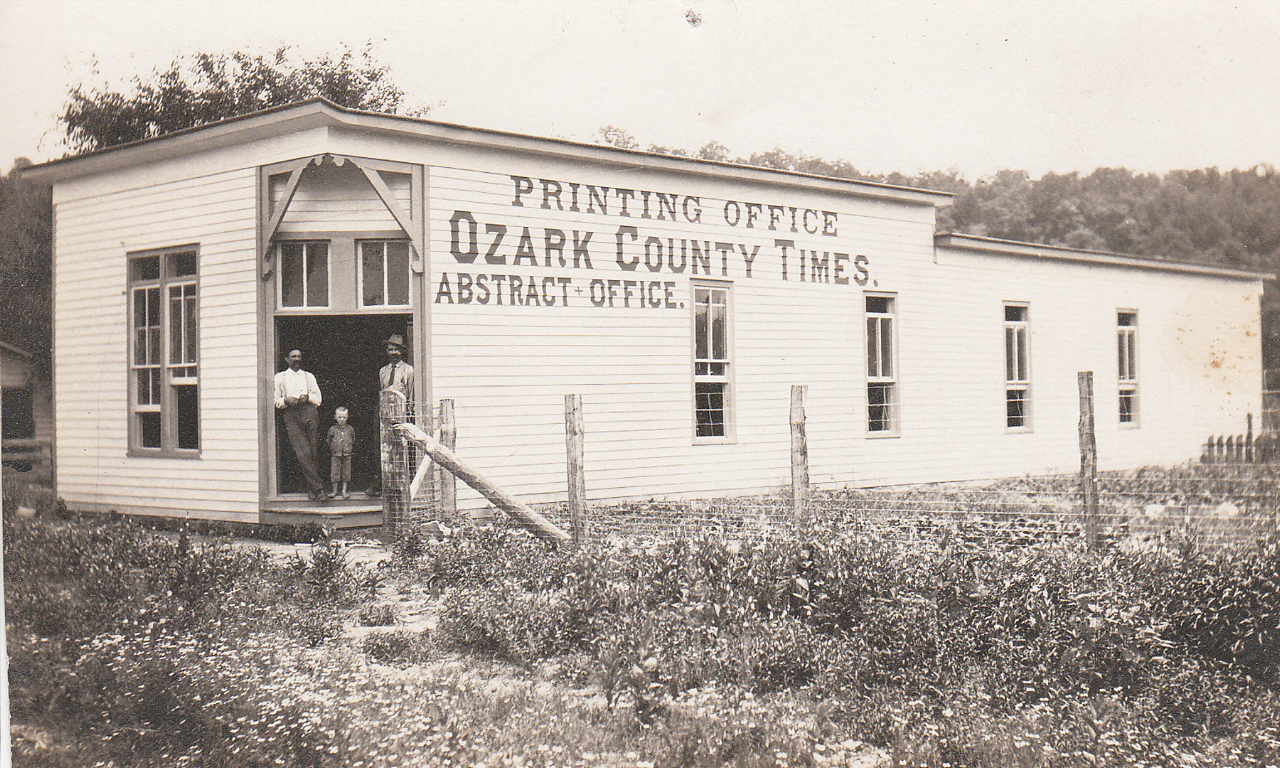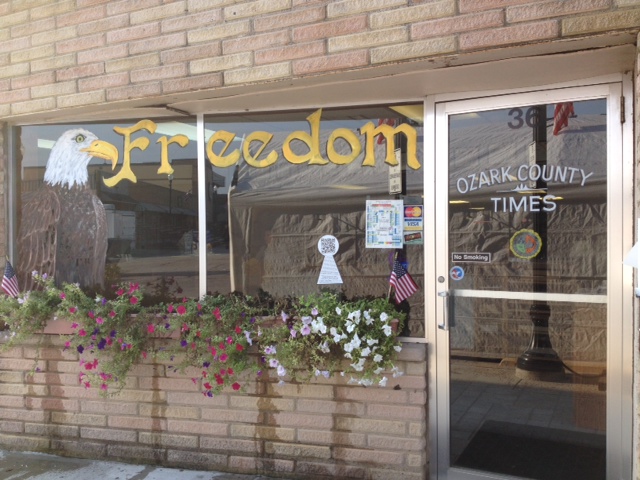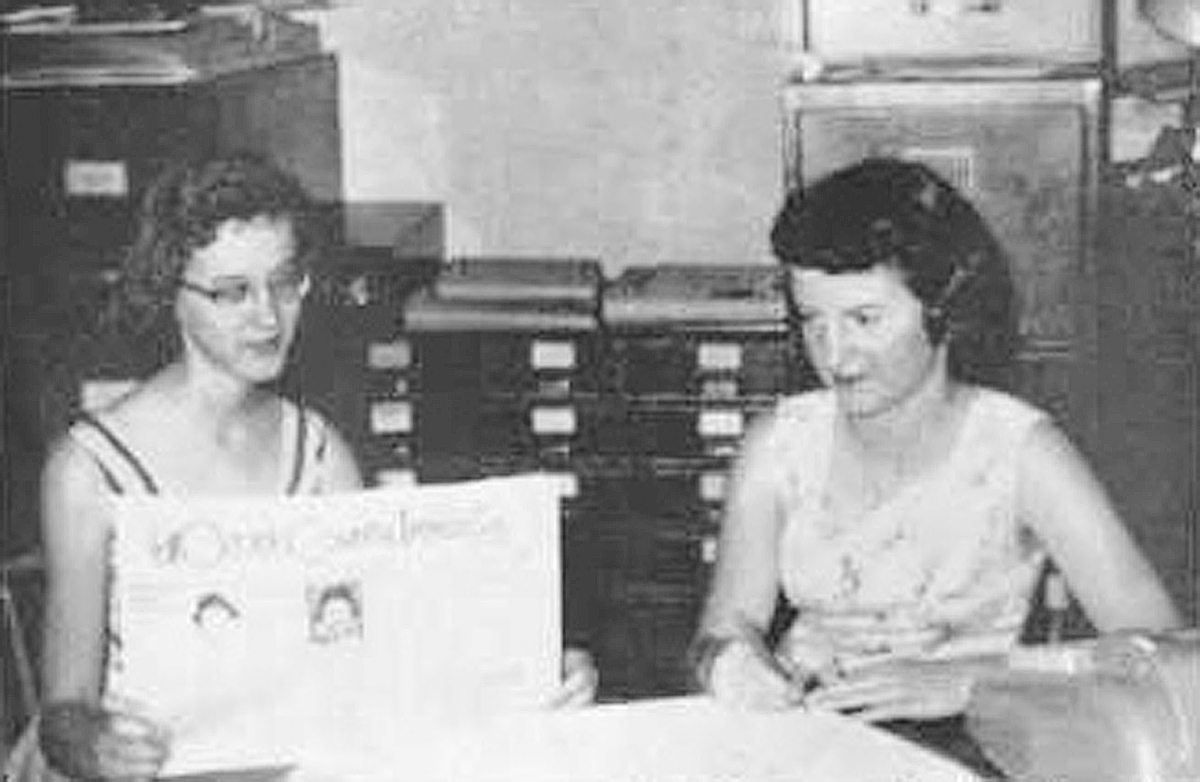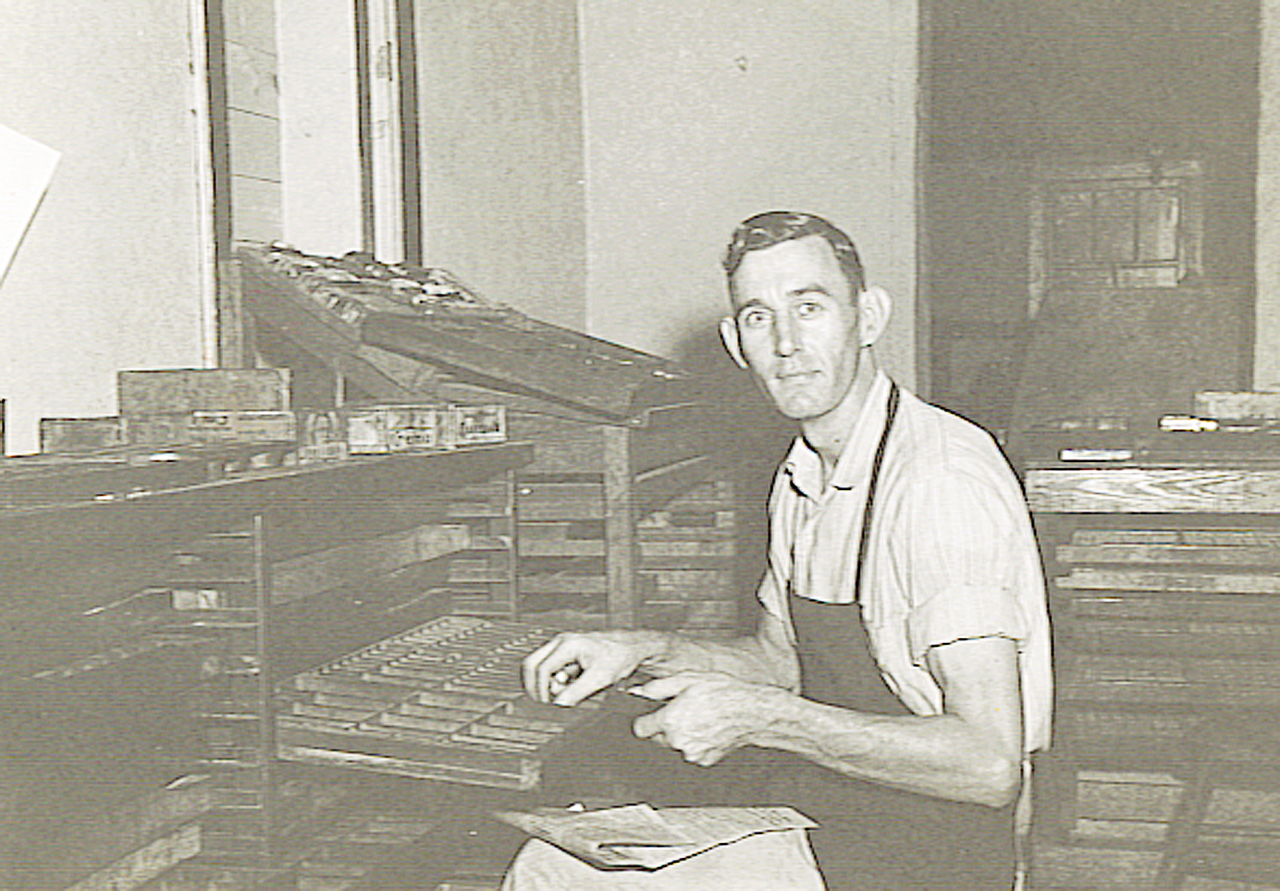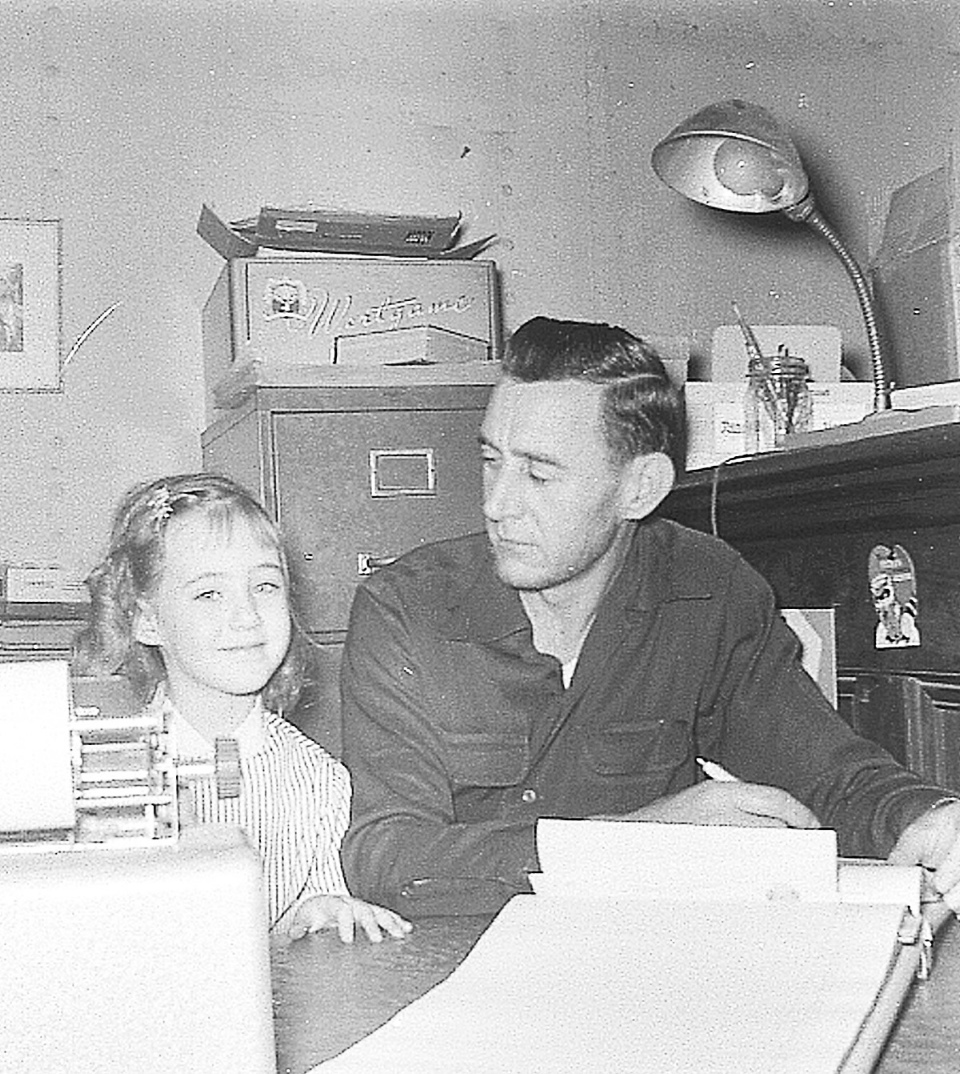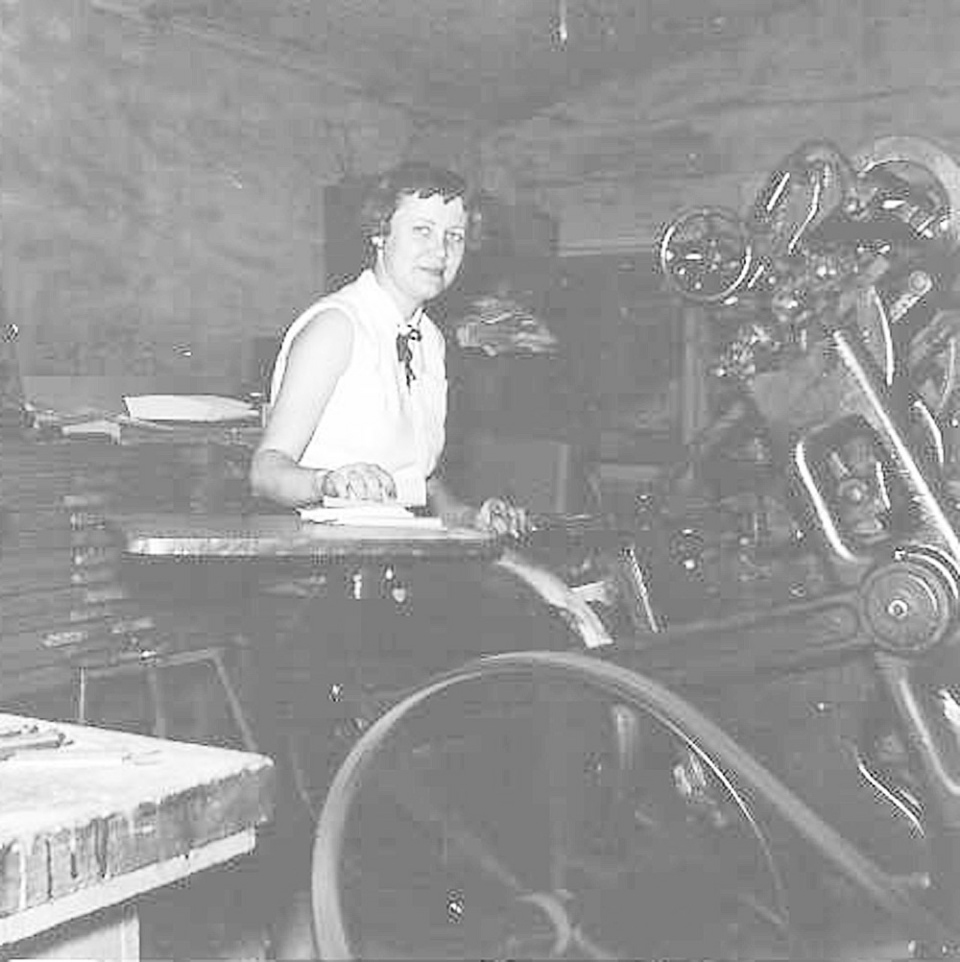Ozark County Times
Ozark County Times
The first newspaper in Ozark County was named the Gazette Tribune and was published by J. W. Mathews form 1876 to 1879. There is a record in the county clerk’s office of Mathews’ being paid for a legal publication in 1876. The publication of land claims was one of the reasons for the founding of these early papers.
The next paper in the county, the New Era, was published by C. B. or Brock Storts from 1881 to 1883. Storts was followed by W. A. Conklin, who published the Weekly Ozark County News from 1883 to 1897. This is the first time the words Ozark County appeared in the name of the county paper. [It is to this paper that today’s Ozark County Times traces its lineage – 130 years – Ed.]
D. C. Turnbaugh is said to have bought out Conklin, and in January 1898, he published the Ozark County Weekly News. He changed the name to the Ozark County News in July and published the News until 1905, when he bought the rival Ozark County Times, which had been founded by the Layton brothers and John T. Harlin, beginning publication on Nov. 1, 1901. Turnbaugh then merged the two papers under the name the Ozark County Times. …
On Nov. 9, 1905, the Ebrite brothers appear as publishers of the Times, having bought the paper from Turnbaugh. The brothers, Earle W. and Harry, had in 1905 bought the Democrat, a paper published by G. W. and W. C. Boone from 1904 to 1905. The Ebrites merged the Times with the Democrat, which they had renamed the Republican. In 1908 Earle W. Ebrite, noted longtime editor of the Times, built the Times building that was destroyed in the Feb. 14, 1963, fire.
Ebrite’s original building was altered some in the late 1940s.
Harry Ebrite, Earle’s brother, did not remain long in the partnership. Earle owned the paper from 1906 until he sold it to Marvin Tong in July 1947. During Ebrite’s later years, his son Dewey and his daughter Helen Ebrite Blisard edited and published the paper.
For a time, they were aided by Dewey Ebrite’s son, Ross. Ray Ebrite, another of Earl Ebrite’s sons, also at one time worked at the Times. …
E. K. Dunnegan bought the Times in 1948 and operated the business until he sold it to Carl White and J. W. Daniel in January 1952. Dunnegan added a metal roof and false front to the bulding.
On Dec. 10, 1953, Daniel and White sold the Times to D. D. Lewis of Texas County, who sold it back to Daniel on Dec. 21. J. W. Daniels sold the Times to Fred and Ruby Robins on Jan. 1, 1959. Dewey Ebrite and Helen Blisard continued on as staff members, and later Don Reed, a native of Ozark County, joined the staff and also Dan Fuller, a native of Washington, D.C. …
This chronology of Ozark County newspapers that have been publishing in Gainesville has been compiled from old newspaper files, records at the State Historical Society, Ayers Newspaper Directory and personal interviews with the family of Earle W. White and others.
This history of Ozark County newspapers published in Gainesville is adapted from a story by the late Ruby Robins that was published in the Ozark County Times on Feb. 21, 1963, following a fire that caused heavy damage to the building on Feb. 14, 1963. Ruby and her husband, Fred, rebuilt the current building on the same site that same year.
Working at the Times
One summer when I was in high school, my mother, Stella Luna, and J. W. Daniel, the editor of the Ozark County Times, worked out a “deal,” where Mom would teach J. W.’s daughter Glenda and me to type and he would teach us to run the Linotype machine.
At that time you didn’t take typing until you were a junior in high school. Mom was teaching us early so we wouldn’t have to “waste” an elective taking typing. And in her mind, if something happened to our parents and we had to work our way through college, running the Linotype would pay more than just being a typist.
Mom kept her end of the deal. We learned to type, and J. W. hired us to work at the Ozark County Times. I got paid 75 cents an hour. I’m assuming Glenda got paid too. J. W. let us “cover” some things such as who won what at Dairy Day or at the horse show, etc.
We also worked the front counter. If anyone bought anything, we were to enter it into the “ledger.” We also proofed stories and ads to make sure there were no typos.
On Thursdays, press day, one of us had to sit at the end where the papers rolled off the big, hot, noisy press and make sure they stayed straight – or something. Actually, I’m not sure why we had to do that, but we did.
Also, we would help wrap the papers and get them ready to mail that afternoon.
I have no idea how many hours I worked a week, but it left time for socializing. Summers were especially good for overnight slumber parties, where no one ever slept.
One night in particular I stayed up all night at a friend’s slumber party and then went to the Times to work the next day. I hate to incriminate Glenda on this, but I’m pretty sure she was at that party too. I remember being rather proud of myself the next day that I was at work and not complaining about my lack of sleep.
The fountain pen we used to enter items in the ledger ran out of ink that day, and I refilled it. I think I made several entries before I discovered I’d put green ink in the fountain pen!
I know I made some other dumb mistakes that day that I have forgotten, but the one Glenda and I were “famous” for was that we proofed Ford’s Village Market’s ad for coffee that day and let “COFFFF” slip by! I think all the papers were printed before anyone caught it.
I’m sure that ad cost J. W. some money, but if he got on to us, he did it in such a mild way that I don’t remember it. And he let me work there the rest of the summer!
He never did teach us to run the Linotype though.
By my last summer in high school, 1959, Fred and Ruby Robins had bought the Ozark County Times. I got to work for them too, but they didn’t trust me to “cover” stories, and I don’t remember proofing anything.
Instead I worked on a new labeling system for the papers, and sometimes Fred sent me out to sell ads. I always hated doing that because I felt like people bought ads from me because everyone in town knew me – and a lot of them were related to me. It would have been like saying no to a Girl Scout selling cookies, I guess.
So when Ruby was to write something about Ozark County for the Ozarks Mountaineer, and the Mountaineer wanted some Ozark County resort advertising, Fred and Ruby sent me out to sell ads for the Mountaineer. Except I was to get a commission from the Mountaineer for selling ads! I think I got 25 percent of what I sold. I really dreaded that because, unlike in town, those resort owners did not know me. Most of them weren’t even related to me.
But I guess it still was like saying no to Girl Scout cookies because I made about $150 selling ads for the Mountaineer in one day! I thought I was rich. But I still decided I did not want to sell advertising for a living.
Mary Ruth Luna Sparks, now living in Raymore with her husband, Mike, earned a Ph.D. in journalism education. Before her retirement served as head of the communications department in Texas Woman’s University in Denton. She compiles the Times Past column each week for the Ozark County Times.
Celebrating 130 years of Ozark County’s Family Scrapbook
The Nov. 22, 1951, issue of the Ozark County Times bore on its front page a plea for blood donors, promising that the blood would be sent to American military personnel fighting abroad: “The blood you give (at the Bloodmobile on Dec. 11 at Gainesville High School) will be in Korea by Sunday, December 15, ready to save a life.”
Nearby was a single paragraph announcing the death of “Aunt Martha Sanders,” who had lived with the family of her daughter, Mrs. Clyde Pitts, of Locust.
In the center of the front page was an ad for the upcoming Lions Club pie supper to support the Gainesville Library. “Come early for a good time,” the ad said. “Bring a pie and help somebody die—laughing.”
Then, over in the “Locals” column was a little three-line item noting the birth of a “fine new daughter” to Mearle Luna and his wife.
My birth announcement, here in the Ozark County Times.
If you’re an Ozark County native, your birth announcement probably appeared here too. If you’re not a native, your move to this area may have been noted by one of the community correspondents.
The Ozark County Times is like a big family scrapbook that has, for 130 years now, recorded the lives of Ozark Countians, for better or for worse. We’re delighted to celebrate that history this week in this 130th anniversary issue – although our math might be off a little. Ozark County newspapers appeared, disappeared and merged so many times, it’s difficult to identify the one magical moment when the ancestor of today’s newspaper was actually “born.” But we decided a celebration is in order, and the newspaper you’re holding in your hands or reading online is the result.
Our thanks to the many supporters and writers who shared memories and photos for you to enjoy, and to our loyal advertisers whose financial support continues to make this publication possible.
There’s a lot of talk these days about how newspapers are struggling against the competition of TV, radio and Internet news. For a lot of national newspapers and big-city dailies, it’s true. But community newspapers, for the most part, are doing just fine, thank you, continuing the work we’ve done for decades. At the Ozark County Times, our job is to continue the big Ozark County scrapbook that’s been recording the lives of your family and mine for 130 years now.
A big-city paper might not care that your child was citizen of the week at his or her school. A national newspaper probably wouldn’t publish a local correspondent’s request that readers pray for an ailing neighbor. And someone who showed up with a monster-sized turnip to be photographed for the metro newspaper’s next edition might be laughed right out the door. But that’s because they’re big-city dailies and national publications, not a family scrapbook recording the daily life of a few thousand Ozarkians.
As my sister, Mary Ruth Luna Sparks, has combed the archives putting together each week’s Times Past column for this newspaper, she has come across the names of our grandparents and great-grandparents and dozens of other family members who’ve made their home here. For generations, our family’s happiest and hardest moments, and most every moment in between, were lived out in these hills. And many of them were recorded in the Ozark County Times.
I was working in the Times office in 1968 when news came that my dad had dropped dead of a heart attack. And I was out doing an interview for the Times 40 years later, in 2008, when news came that my husband had died unexpectedly the same way. This newspaper is part of my personal history.
If you’re an Ozark Countian by birth or by residence, it’s part of yours as well. It’s likely that your family’s happiest and hardest moments are recorded here too: births, graduations, birthday parties, baptisms, graduations, accidents, travels, accomplishments, marriages, children’s and grandchildren’s births, loved ones’ deaths. Thousands of family milestones have been recorded in the pages of this newspaper.
My own family is a perfect example. In addition to my own birth announcement, my children’s birth announcements were published here too, and my first grandchild’s arrival was happily shared here as well. My parents’, grandparents’ and husband’s obituaries were printed here. Someday my own obituary will surely appear here too.
But it’s not just the important life events that make the pages of the Ozark County Times such an invaluable record of life here. We record the ordinary moments too, as a good scrapbook does. The community correspondents report on the activities of everything from houseguests to hummingbirds – and when a correspondent misses a week, her readers are disappointed.
If you kill a big deer, catch a big fish or grow a big tomato, we’ll publish the picture.
If your house burns down, you wreck your car or the creek floods your barn, we’ll publish that picture too, if we can get it.
We want to pack each issue full of all the Ozark County news we can squeeze into these pages. To do that, we rely on our Ozark County family members – that would be you – to help us keep the scrapbook current and interesting.
The news tips and photos you send us via e-mail or call in to us by phone are invaluable. Times staff members wear many hats, doing other jobs in addition to collecting the news, and we consider all of our readers as deputized reporters.
Please keep sending us your family’s news. Share those happiest and hardest moments, those pictures of funny-shaped gourds and huge pumpkins, of newborn babes, proud graduates, newlywed sweethearts and then the next generation of newborn babes. Tell us the story of a family member’s life, well lived. And together we’ll keep the Ozark County scrapbook going for another 130 years, week by week, in the Ozark County Times.
Ozark County Times editor Sue Ann Luna Jones began her journalism career at the Times office in 1966. This article is adapted from a column first published in 2010.
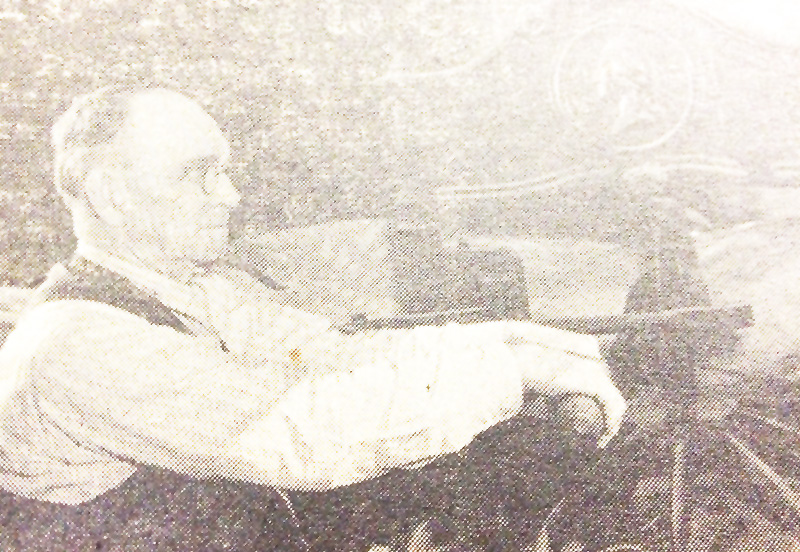
Printer’s Ink
Earle Warren Ebrite (1866-1958) was the longest-tenured editor of the Ozark County Times in the newspaper’s history. For 40 years, from 1906 to 1946, E.W. collected news, wrote articles and published the weekly newspaper, never missing an issue.
Those were very different days for the industry, when each piece of type was set by hand and the old press was turned manually, cranking out page after page. The pages were then assembled and folded together, again by hand, ready to be delivered or mailed. I wonder what the old editor would think if he could observe his newspaper (still in print each week) being put together today. Would he wonder at the sight of fingers flying across computer keyboards, images being inserted at the point of a “mouse” and printing occurring with one magic keystroke? Would he miss that pungent smell of ink pervading the office as he set up a job?
Grandpap must have had ink in his blood, for he knew at an early age that he wanted to become a printer. His father, Dr. George W. Ebrite, wrote in 1885 that his oldest son, “now in his 19th year, is a printer by trade.” Young Earle had attended school in his hometown of Auburn, Pa., until the family migrated to Mount Pulaski, Logan Co., Ill., in 1882. At that time, Earle became an apprentice in the office of that town’s newspaper, the Mt. Pulaski Citizen, where he worked until the family again pulled up stakes, this time for their move to Ozark County.
It is noted in a biography of George that “during the campaign of 1884 he edited the Mt. Pulaski Citizen in advocacy of the election of President Cleveland.” Evidently, George shared his son’s interest in printing and journalism.
In 1886, the George W. Ebrite family, consisting of his wife, Sarah, sons Earle and Harry, and daughters Annie, Mamie and Jennie, settled east of Gainesville on Lilly Ridge. A young son, Charles, died at age 4 back in Pennsylvania, and Annie died shortly after they arrived in Missouri.
Earle married Mary Adeline White, the daughter of William and the late Vashti Staton White, in 1888. In an article in Missouri, the Center State: 1821-1915, Earle said he “took up a homestead near Gainesville, giving up newspaper work on account of ill health.” For 18 years, he and Adeline farmed and had six children: Rachel, Helen, William Ray, George Dewey, Charles and Leonard. But in 1905, the old interest in printing was rekindled when an opportunity came along.
According to an interview with Earle printed in the Times in 1953, his brother Harry, who was working for The Democrat, then published in Gainesville, came to him to say that he had a chance to buy the paper and asked if Earle would be his partner. The Ebrite brothers purchased The Democrat from George W. Boone and W.C. Boone, and immediately changed its political allegiance and its name.
Their first paper, now called The Republican, featured the following notice: “Having purchased the Democrat plant, we have converted it into a Republican paper, published in the interest of the Republican party and the public in general, giving all local happenings and other news matter.”
In 1906, the ambitious brothers bought a second paper, the Ozark County Times from D.D. Turnbaugh and combined the two papers, keeping the name of Ozark County Times at the request of Mr. Turnbaugh. Subscriptions were 50 cents per year, and it was hard work. Earle noted, “We used the old Washington hand press, which printed one paper at a time, requiring two to run it, one to insert the paper and one to roll the ink on the type, and all the type was set by hand.”
In 1908, to be close to his work, Earle and Adeline Ebrite moved their young family into a house on the Gainesville town square that they purchased from E.K. Sanders; it was right next door to the newspaper office. In 1912, Harry decided to sell his interest in the newspaper to Earle and move to Oklahoma. That was the impetus that led Helen, the oldest surviving child (Rachel and Charles had died by then) to follow in her father’s footsteps; she learned to set type and later the Linotype. Sons Ray and Dewey were the official “inkers” for that old Washington press, and Leonard helped out in odd jobs. (He also had a little ink in his blood, for he worked on the Ozarko, the yearbook of the State Teachers’ College in Springfield when he was student there in the 1920s.)
Putting out the Ozark County Times was a family affair. Helen remained at the newspaper, even after her father sold it, until she retired in 1960.
Earle’s early interest in politics continued throughout his life; he was elected as presiding county commissioner in 1938, and he was mayor of Gainesville for 20 years. He was a tireless promoter of progress in the county and always used the paper as a voice for support of projects that were positive and beneficial.
In 1946, 40 years after the Ozark County Times came into the possession of Earle W. Ebrite, he finally retired, at age 80, “to his rocking chair on the front porch of the same house he brought his family to in 1908.” He was content, then, “to read the evening papers, smoke his pipe and make a weekly trip to the barber shop.” No doubt, Grandpap also continued to enjoy the comings and goings of Ozark Countians since his front porch faced the courthouse.
Earle Ebrite died at the age of 92 and was buried at Lilly Ridge Cemetery alongside his first wife, Adeline, who died shortly after their 50th wedding anniversary. (After her death, he married Dora Luttrell, who survived him.)
It seems like a long time ago, back in 1956, when our family gathered for a 90th birthday party for the old man. We have a picture of seven of his eleven great-grandchildren with him: Ronnie and Donnie Luna, Randy and Cindy Ebrite, Joe Lee Gott, and my brother, Greg, and me. I didn’t know it at the time, but that was quite a day – a time to celebrate with this patriarch who left such a wonderful legacy for us, a history that is so integral to the history of Ozark County. For the newspaper is the very keeper, the repository of the history of a place.
I love to look back through the yellowed pages and see his work of his hand – “ye scribe” is how he often referred to himself, keeping the good journalist’s rule of avoiding the use of writing in first person. What joy to read his comment when my dad (his grandson) was born: “Born to Mr. and Mrs. Leonard F. Ebrite, a fine boy. It arrived early Christmas morning. Mother and baby doing nicely, also Leonard, but Grandpaps Bushong and Ebrite are requiring extraordinary and careful treatment.”
Sometimes, Grandpap’s heart could not keep from shining through.
I’ve also been proud to follow in Grandpap’s footsteps by having the opportunity generously given by the current publisher and editor to write stories for the Ozark County Times. When I first saw a feature with my name in the byline, I thought of Grandpap and hoped he would be proud, too. Strong stuff, that printer’s ink. Guess there’s a bit of it still flowing in my bloodstream, too.
Janet Taber, a graduate of Gainesville High School and the University of Missouri and a frequent contributor to the Times, lives and farms in Ozark County with her husband, Stan. She is the great-granddaughter of longtime Times owner and publisher Earle Ebrite.
The Times’ Family of Journalists
There are those who say the 1950s weren’t as wonderful as we remember. Oh, but they were! It was the decade that my parents, J.W. and Margie Daniel, were the proud owners of the Ozark County Times.
They bought the paper in 1952. My father was 35, Mother was 29, I was barely 1 and my sister, Glenda, was 9. What were they thinking? Maybe what most everyone in their generation thought: It was their time, and they were unstoppable. They were pretty much right about that.
J.W. had been working for newspapers in Mountain Home since high school, interrupted only by his World War II service in the Navy, Pacific Theater. During and after the war, they somehow saved enough money to buy their dream. They had a partner for one year, Carl White, but my sister and I don’t remember much about him. Within a year, they were the sole owners.
On July 2, 1952, President Harry Truman dedicated Bull Shoals Dam. It was a turning point for Ozark County and also my father’s 36th birthday. With press credentials, he was able to get up close and personal with Truman to record the day. As the son of a divorced mother of eight who supported her family by sharecropping during the Depression, he must surely have marveled at how far he had come. I know he was tremendously proud of those who had made the dam a reality and tourism the future.
Meanwhile, my parents found out that owning a newspaper was going to require a very creative business model. They had two especially talented employees who came with the paper and knew how to put it out: siblings Dewey Ebrite and Helen Ebrite Blisard. But then there was the problem of advertising.
Ozark County businesses were short on cash. So Margie and J.W. took much of their classified advertising and many of their subscriptions in trade for vegetables, fruit and sides of beef. For the merchants’ display ads, it was whatever they were selling. We had an abundance of new furniture and amazing household gadgets and new cars every year. I think we were one of the first families in Gainesville to have a TV, courtesy of Western Auto. That was good news and bad, as you will see.
The best thing about owning the paper was being a part of Gainesville and Ozark County, in every way. My parents were active in the First Baptist Church, and I seem to remember that Daddy was a deacon. Mother belonged to civic clubs, and my sister and I made lifelong friends.
The office was a playground for me and my buddies. Sue Ann Luna Jones, Janet Ebrite Taber and others climbed all over the old Washington hand press we still had in the back room, and we made downhill slides of the cardboard holders for the newsprint we used on the flatbed press. When I was 6, my father started paying me 10 cents an hour to insert white, yellow and pink paper for job printing with carbon paper. If you don’t know what I’m talking about, you must ask an older person.
Glenda and Mary Ruth Luna Sparks wrote stories for the paper in high school. Glenda also operated the folding machine and helped wrap the papers for delivery early on Thursday morning, rolling them up in sheets of white paper sealed with homemade flour paste.
By 1957, Glenda and I both had newspapering ambitions. Glenda decided that she wanted to major in journalism, and I informed Daddy that I wanted to be a Linotype operator, just like Miss Helen. To his credit, my father promptly showed me how to set my initials, SJD (J for Jo), in 120-point type on the towering, hot, thunderous Linotype machine. I still have those three precious pieces of lead.
The unfortunate end of this story is that in 1959 my parents faced the reality of being rich in friends and goods taken in trade, but with not enough greenbacks to send Glenda to college. They sold the paper in 1959 to Fred and Ruby Robins, who proved to be the best of stewards. My father became editor of the Branson White River Leader for a year, and then we moved back to Mountain Home, where he and my mother returned to The Baxter Bulletin and eventually retired. He died in 1996, my mother in 2001.
Glenda and I followed our parents into journalism. She worked for the Chicago American and Chicago Today then moved to leadership in several environmental nonprofits in the six-county Chicago area for four decades. She retired in May and now lives in northern Spain with her daughter, son-in-law and two grandchildren.
For three decades I was a reporter and editor for the Chicago Tribune, Los Angeles Times, International Herald Tribune and several other magazines and newspapers in the United States, Southeast Asia and France. A few years ago, I came to my senses and returned home. I’m now the grants administrator for Marion County, Ark. I live on the White River, and life is almost as good as it was in the ’50s.
Did you know?
- The Ozark County Times dates all the way back to 1876?
- There was a fire that caused heavy damage to the Times building on Feb. 14th, 1963?


Funding for the Schoolcraft Journey project on Unlock the Ozarks has been provided by the Missouri Humanities Council.
